Important Intangible Cultural Property Echigo Jofu 100 Tortoise Shells Two techniques that are no longer possible in modern times |
| |
Special products using techniques that can no longer be made
This Echigo Jofu is a nationally designated Important Intangible Cultural Property.
The tortoise shell pattern is woven all over the fabric using very thin ramie thread.
It is made of 100 tortoise shells, and 100 tortoise shell patterns are woven into the width of about 1 shaku (just under 38 cm).
In order to weave this tortoiseshell pattern, special thread binding is required, but two techniques are used that are no longer possible in modern times.
It was made in the late 1960s, and although it was a technique that existed at that time, it is no longer possible in modern times.
In addition, it is no longer possible to make such fine 100 tortoise shells, and even 80 tortoise shells.
In other words, Echigo Jofu retains the highest level of delicate techniques.
Since the tortoise shell is a process of repeated detailed work, it can also be used as a standard to measure skill.
The fineness of 100 tortoiseshells itself tells us how thin the thread is, how difficult it is to make the thread, and how difficult the sizing machine is.
This fineness and high quality make it feel light, cool, and easy to wear when put on.
It is precisely because of the hot summer season that Echigo Jofu is made from hemp, which is washable and highly practical.
Color
The color is a light gray from a distance. It looks plain from a distance.
As I get closer, I can finally make out the tortoiseshell pattern.
The color is not plain, but has a fashionable feel that transcends age.
Click pictures to enlarge
>>The details click here. |
|

Important Intangible Cultural Property Echigo Jofu 100 Tortoise Shells Two techniques that are no longer possible in modern times
|
price: 8,640,000 yen
|
(rate:)
|
( Product No: 0000n8160mh001ki )
stock status:
|
|
| Orders by e-mail or fax (
81-3-5652-6869) are also available. |

 |

 |

 |
Value proven on the TV show gItfs Laughableh
 
This Echigo Jofu was featured on July 3, 2012 on Fuji TV's ``Waratte Iitomo.''
Ranking of how much is 10,000 yen! Luxury Kimono for Celebrities: Oikura Ten Thousand Yen Tsumugi Edition
Items ranged from 20 million yen worth of Echigo Jofu to 10,000 yen worth of recycled cotton pongee.
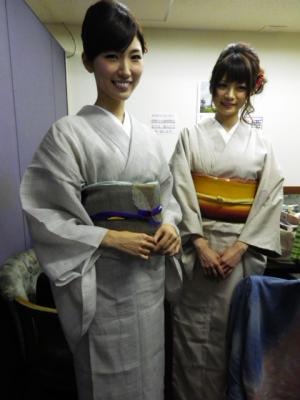
It was exhibited as Echigo Jofu for 20 million yen.
http://www.kimono-bito.com/keisai/fuji-iitomo20120703.php
It was tailored for that purpose.
In addition, it is a masterpiece that uses the highest quality techniques that can no longer be made, so there is no way to put a price on it.
However, the price is based on the recognition of the value of over 20 million yen.
Length 4 shaku 1 sun 5 minutes, sleeve length 1 shaku 8 sun 2 minutes, sleeve length 1 shaku 3 sun, back width 7 sun 7 minutes, front width 6 sun 5 minutes
Important Intangible Cultural Property Echigo Jofu
Characteristics of Echigo Jofu
Echigo Jofu is a plain-woven linen fabric currently produced mainly in Minamiuonuma City and Ojiya City, Niigata Prefecture.
In 1955, both Echigo Jofu and Ojiya Chijimi were designated as Important Intangible Cultural Properties.
In 2009, it was also registered in UNESCO's ``Representative List of the Intangible Cultural Heritage of Humanity'' of the Convention for the Safeguarding of the Intangible Cultural Heritage.
It is the highest quality of cloth and is a representative textile of Japan, which is known as ``Echigo in the East, Miyako in the West.''
During the Heian period, cloth was given to the imperial court, and in 1560, Uesugi Kenshin sent Echigo cloth to the imperial court, making it an indispensable gift for those in power.
The characteristics of Echigo Jofu are its rarity and the fact that it is woven using manual techniques.
With its highly breathable, light and smooth texture, it is the highest quality fabric perfect for the hot and humid Japanese summers.
Production process
Choma, the raw material for Echigo Jofu, is hard and taut.
For this reason, it is difficult and important to remove thin threads.
http://www.kimono-bito.net/wp/wp-content/uploads/2015/05/IMGP8817.jpg" alt="" border="0">
In Okinawa, where the weather is warm, yarn is harvested four times a year, but in Showa Village, Fukushima Prefecture, where Echigo Jofu yarn is produced, yarn can only be harvested once a year.
Ramie is a perennial plant that sprouts every year.
However, natural ramie is not uniform as a thread, so it is cultivated.
On May 20th, Koman, we burn the fields.
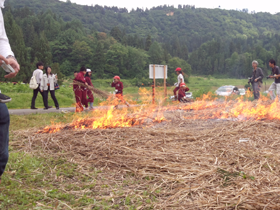
Burning the emerging buds helps exterminate pests, keeps the buds uniform in length, and makes the soil alkaline.
This is a cultivation method that has been passed down since the Jomon period.
Then, they will sprout all at once.
It is vulnerable to wind, so surround it with Yoshi to protect it from the wind.
In late July, cut off the nearly 2m-tall plants that have grown and immediately soak them in water.
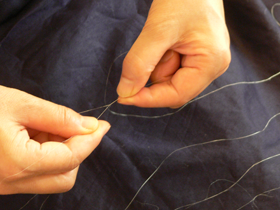
It will get soggy, so remove the outer layer and remove the inside.
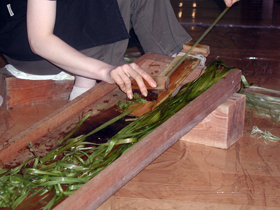
A beautiful grass-colored ramie emerges and is dried for about 20 days.
After that, it is sold to a weaver in Shiozawa and graded.
Kageso good yarn
Oyaso (oyster) ordinary thread
Watakushi (shimo) Thick thread used for obi etc.
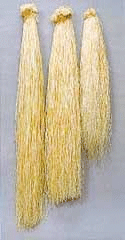
For Important Intangible Cultural Properties, we use Kageimo.
There are also differences in quality of Kageimo, and this difference is reflected in the price.
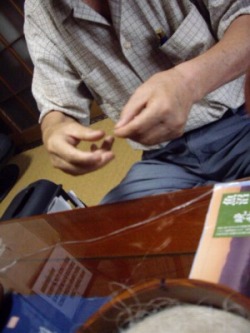
He tears this hemp very finely with his nails and makes a thread, which he ties together.
The life of Echigo Jofu lies in how finely this linen is torn and used as high-quality thread.
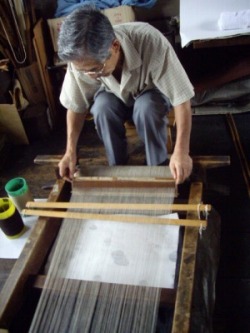
This is the work of adjusting the threads. It's mind-bogglingly detailed.
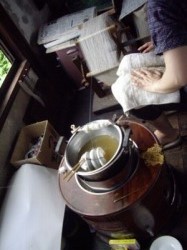
Pass the glue through and apply the glue.
Next, it is woven using an izari machine that uses the waist as well as the thread.
When weaving, always mist the fabric to prevent it from drying out and to prevent the threads from breaking.
Weaving takes place between November and March.
To prevent the threads from breaking, the fabric is woven in a humid north-facing room that is out of the sun and has no air conditioning or heating.
The extremely cold conditions in Niigata are extremely harsh.
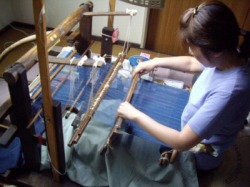 
Since the threads break on high machines, it can only be woven on high machines.
It takes three months for a plain pattern, half a year for a patterned pattern, and longer for an all-over pattern.
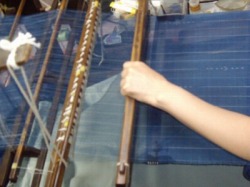
It is thin and very difficult to weave.
Requirements for designation as an important intangible cultural property
The requirements for designating Echigojofu as an important intangible cultural property are as follows.
(1) All threads must be hand-woven from ramie.
2. When applying Kasuri patterns, do it by hand.
3. Weaving on an izari loom.
4. When straining, use hot water or foot massage.
5. Exposure is due to exposure to snow.
Woven products undergo ``ashibumi'' to remove glue and dirt while softening the fabric and clogging the grain.
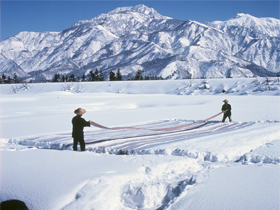 
After finishing, the woven cloth is spread out on a fresh, flat surface of snow during the day on a clear sunny day.
By doing this, the glue and dirt that got on it during production and the original color of the raw material ramie are removed, leaving it pure white and making the pattern stand out vividly.
The principle is that when snow melts and becomes water vapor due to the heat of the sun, ozone, which has sterilizing and bleaching properties, is generated, and when this passes through the grain of the fabric, a chemical reaction occurs and the fibers are bleached. Masu.
Yukisashiri is held for about one week to 10 days from March to April, and has been considered a spring tradition in Minamiuonuma.
Echigo Jofu is a wonderful traditional culture of Japan that has been designated as a World Heritage Site.
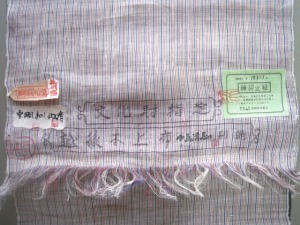 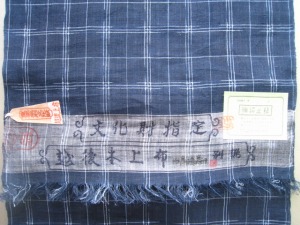
Stripes Lattice
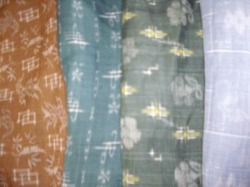
All-over pattern
100 Important Intangible Cultural Properties Echigojofu
There is Echigo Jofu, an important intangible cultural property that uses thread-making techniques that are no longer possible to make.
Echigo Jofu with 100 tortoise shell patterns.
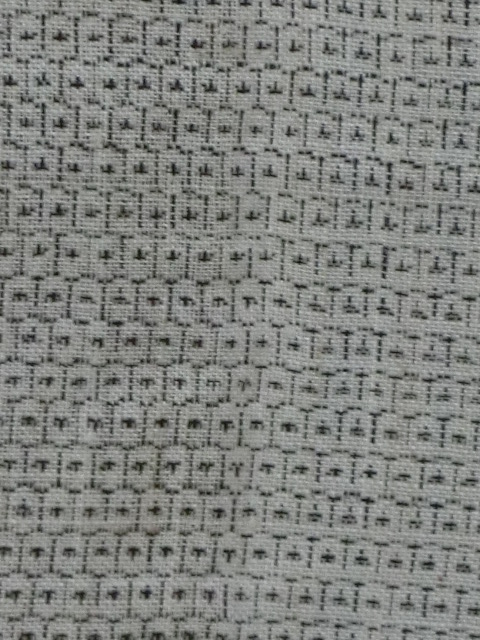
A tortoise shell pattern is woven all over the fabric using thin threads.
Since it is made of 100 tortoise shells, there are 100 tortoise shell patterns in the width of about 1 shaku (just under 38 cm).
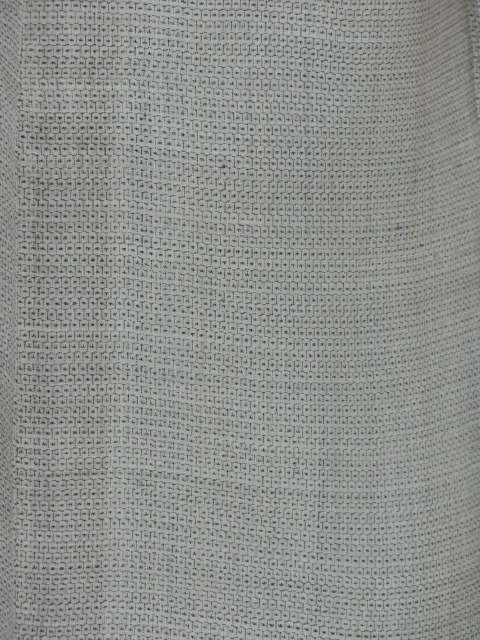
It is a light gray color from a distance.
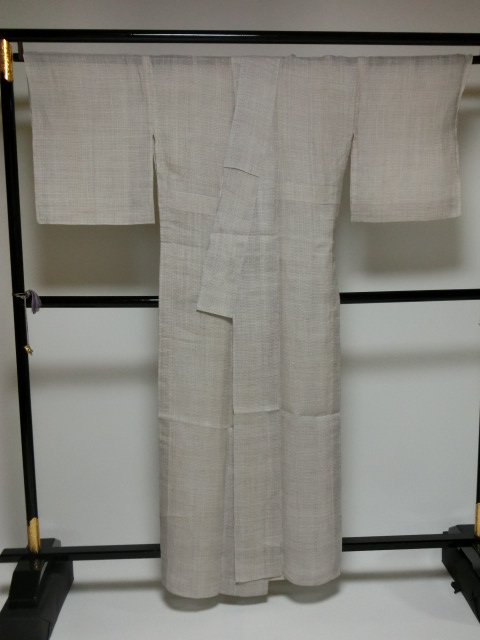
It looks plain from a distance.
Since the tortoise shell is a process of repeated detailed work, it can also be used as a standard to measure skill.
This 100 tortoise shell is a masterpiece among the Important Intangible Cultural Properties of Echigo Jofu.
The fineness of 100 tortoise shells itself tells us how thin the thread is, how difficult it is to make the thread, and how difficult the sizing machine is.
This Echigo Jofu was woven in the 1960s.
Two types of thread-making techniques are used that are no longer possible.
It was no longer possible to weave threads or to weave them, and because we were no longer able to make threads, we were no longer able to weave this textile.
Also, would it be possible to use a slightly larger pattern of 80 tortoise shells instead of 100 tortoise shells?
No, it is no longer possible to weave tortoise shells anymore. The tortoiseshell pattern no longer exists in modern Echigo Jofu.
The tradition of kimono is made possible by all the people who grow the thread, make it, dye it, weave it, and wear it.
Often one person's role is important.
The reason why summer pongee is said to be the most luxurious is because fabrics using hemp thread are sought after to keep cool, and because hemp thread is difficult to handle.
|

Important Intangible Cultural Property Echigo Jofu 100 Tortoise Shells Two techniques that are no longer possible in modern times
|
price: 8,640,000 yen
|
(rate:)
|
( Product No: 0000n8160mh001ki )
stock status:
|
|
| Orders by e-mail or fax (
81-3-5652-6869) are also available. |
|
|